Child Health Day 2021
Published: October 4, 2021
Child Health Day is October 4th, 2021 and serves as a day to promote awareness for the protection and development of the health of children. Children are the future and by recognizing that our children deserve the best possible health, we can help and support them by promoting healthy habits during childhood that carry over into a lifelong commitment to protecting their health (as well as the health of future generations).
In celebration of Child Health Day, the Michael & Susan Dell Center for Healthy Living has prepared a series of seven checklists to spread awareness of the different aspects of child health. These checklists can serve as quick sources of information for you to learn new information regarding your child’s health or as a quick refresher for tips you have already learned through your pediatrician. This post provides detailed information on each of the seven topics covered by these checklists and gives the “why” behind its importance to child health. Happy Child Health Day!
Recommended Wellness Check-Ups1
Wellness check-ups are recommended for infants and children to keep your child healthy and on track during their early developmental years and throughout their childhood. These visits are typically done with a pediatrician or pediatric medical staff and include items such as physical exams, checking for progression of growth and development, vaccinations (if needed), and any other tests deemed necessary to ensure your child is healthy! The recommended wellness check-ups are on the following schedule: 2 weeks old, 2 months, 4 months, 6 months, 9 months, 12 months, 15 months, 18 months, 24 months, 30 months, and annually after 2.5 years old.
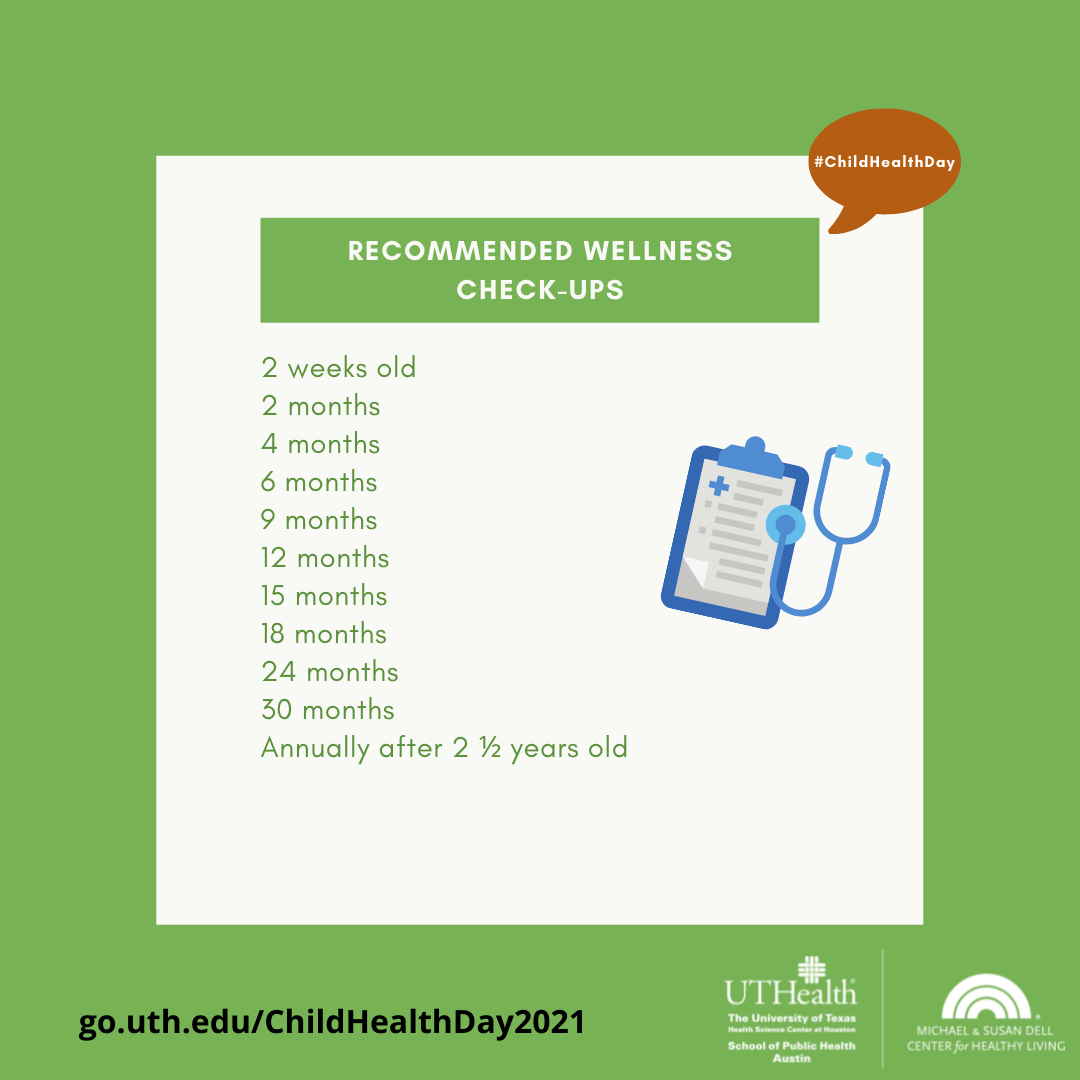
Dental Recommendations2
Dental hygiene is crucial for children’s health because oral health problems (especially untreated cavities) can cause problems with eating, drinking, speaking, playing, learning, and other developmental steps for infants and children. According to the Centers for Disease Control and Prevention (CDC), children that have poor oral health are more likely to miss more school and receive lower grades than children who don’t have poor oral health. Dental check-ups are recommended for children once the first tooth appears under 12 months of age, and every 6 months thereafter. Some tips for cavity prevention in children include brushing their teeth using a soft child-sized toothbrush and water twice a day at age 1-2. Once the child is old enough to spit out toothpaste, they can be switched to a fluoride-based toothpaste to help prevent cavities. Other tips include brushing teeth for at least 2 minutes each time teeth are brushed to make sure every tooth is well brushed, flossing once a day, and limiting fruit juice intake. Oral health is also crucial for teenagers, and they should continue to brush their teeth twice a day, limit sugar sweetened beverages for all youth ages, and floss at least once a day for continued optimal oral health and cavity prevention.
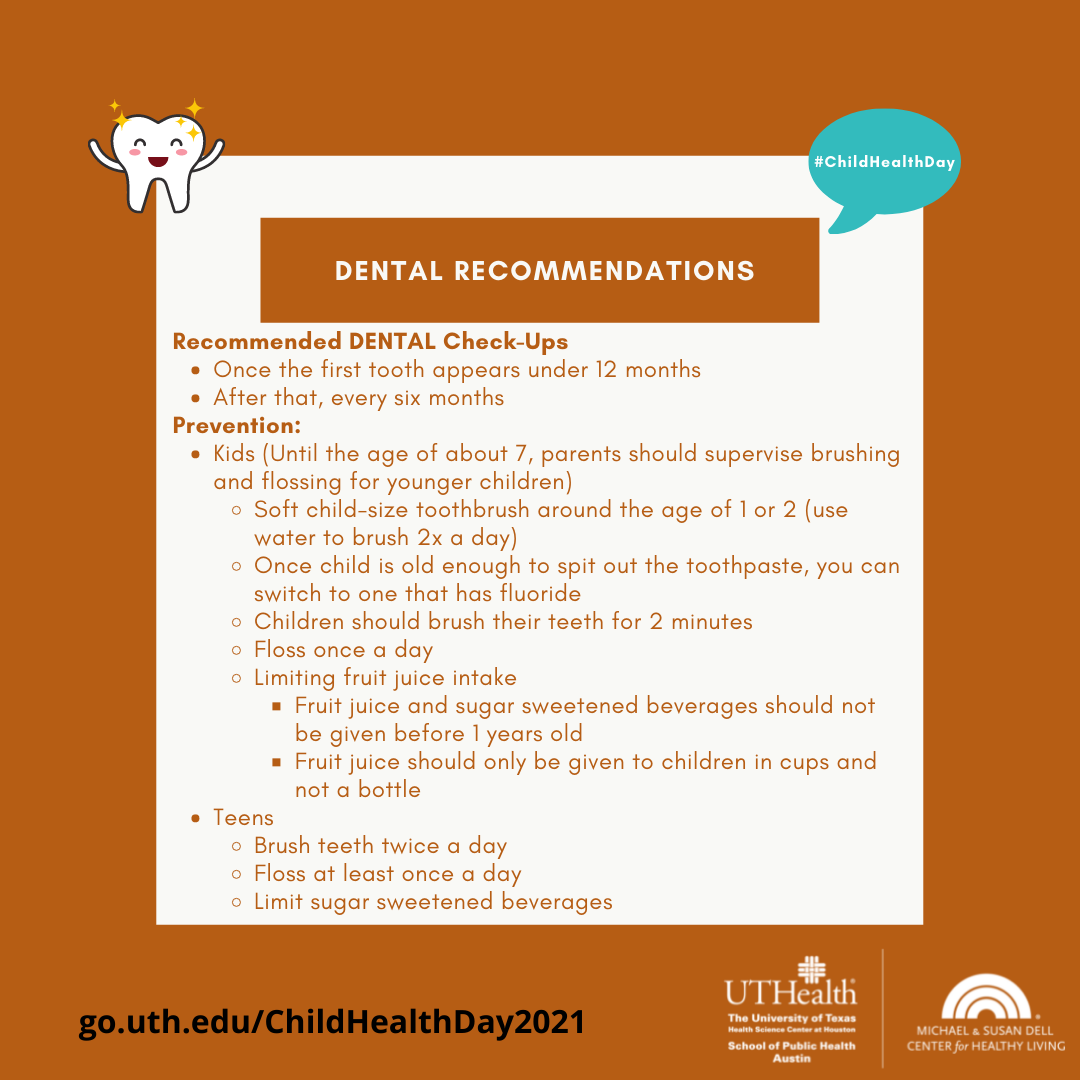
Daily Healthy Food Guidelines3
Daily Healthy Food Guidelines are used as a tool to help guide a healthy eating routine for your child at each stage in their life. These guidelines can provide information on the correct amounts and variety of fruits, vegetables, grains, protein, and dairy each day to ensure that the macronutrient and micronutrient needs for your child are being met! The checklists included divide the daily recommended servings into the following 4 age groups: ages 2-4, ages 5-8, ages 9-13, and ages 14-18. Energy and nutrient needs start to differ between girls and boys around the onset of puberty as more growth occurs, so ages 9-18 are also subdivided by sex to provide accurate information for the nutritional guidelines for your child! If you are looking for additional information on how to create a balanced and healthy eating routine for your child, a great resource you can check out is MyPlate.gov and our CATCH GO SLOW WHOA materials.

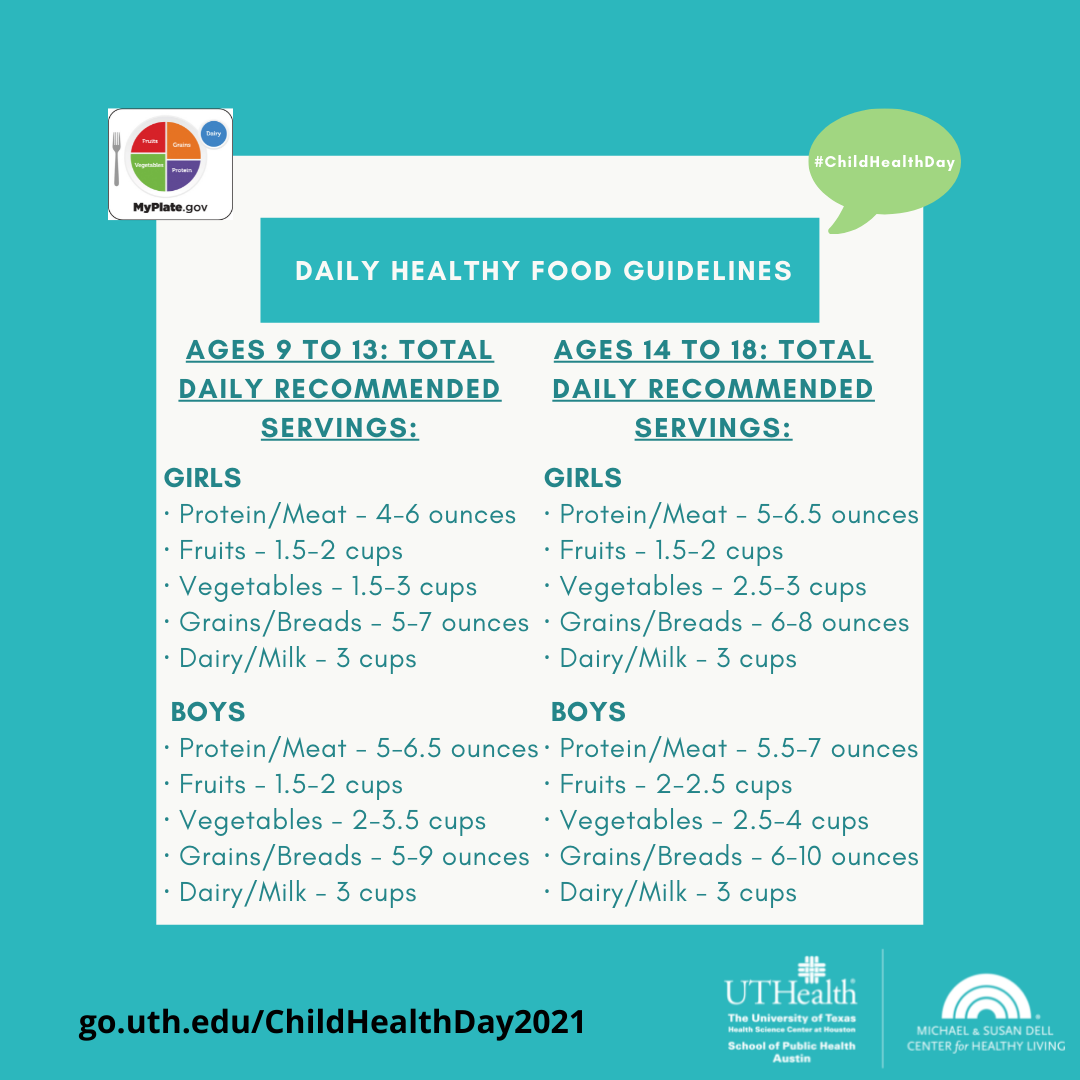
Vaccinations Required for Public Schools4
Several vaccinations are required for public schools in Texas to help prevent your child from contracting vaccine-preventable diseases and to help stop potential outbreaks of these diseases from occurring. Required vaccinations for entry into schools help the state to maintain our high rates of vaccination coverage and low rates of vaccine-preventable diseases. The vaccinations required for public schools include Diphtheria/Tetanus/Pertussis (DTaP/DTP/DT/Td/Tdap), Polio, MMR (Measles, Mumps, and Rubella), Hepatitis B, Varicella, Meningococcal (MCV4), and Hepatitis A. It is important to discuss your child’s vaccination schedules with your pediatrician to ensure that they are on a healthy timeline for their growth and development. More information on exemptions for required vaccinations for public school (based on Texas law) can be found on the checklists.
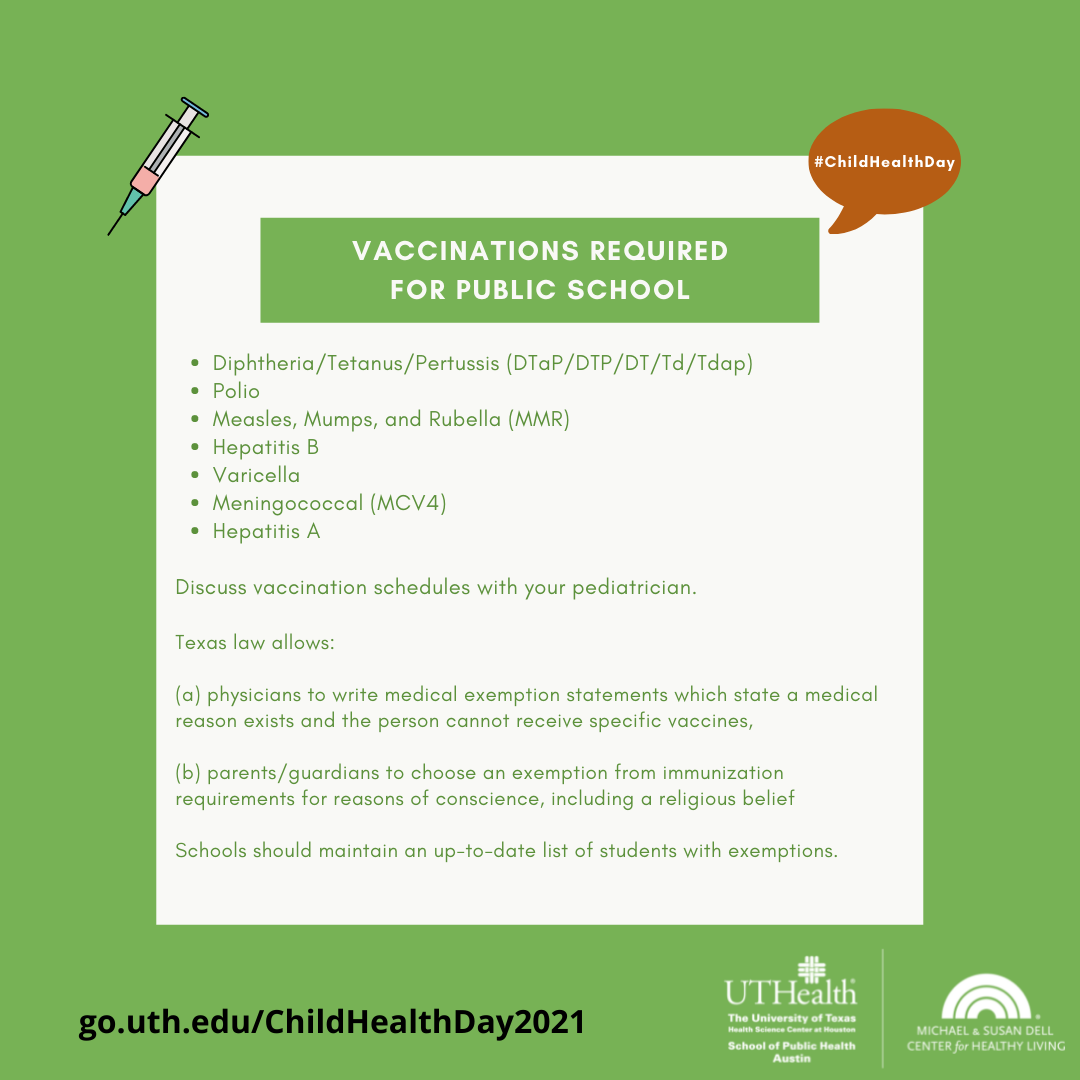

Physical Activity Guidelines5
Physical activity is another crucial player in child health, as regular physical activity in children helps to promote health and fitness. Increased physical activity brings physical benefits for children including higher levels of fitness, lower body fat, stronger bones, and stronger muscles. It also provides other additional benefits including improved cognition, improved academic performance, and reduced symptoms of depression. These guidelines differ between preschool age (3-5 years) and children and adolescents (6-17 years) and are subdivided into the different forms of activity including aerobic activity, muscle-strengthening activities, and bone strengthening activities. The checklists give further recommendations for your child’s age group as well as suggestions for activities that your child can do to hit their physical activity goals! See our CATCH program for a listing of healthy activities.
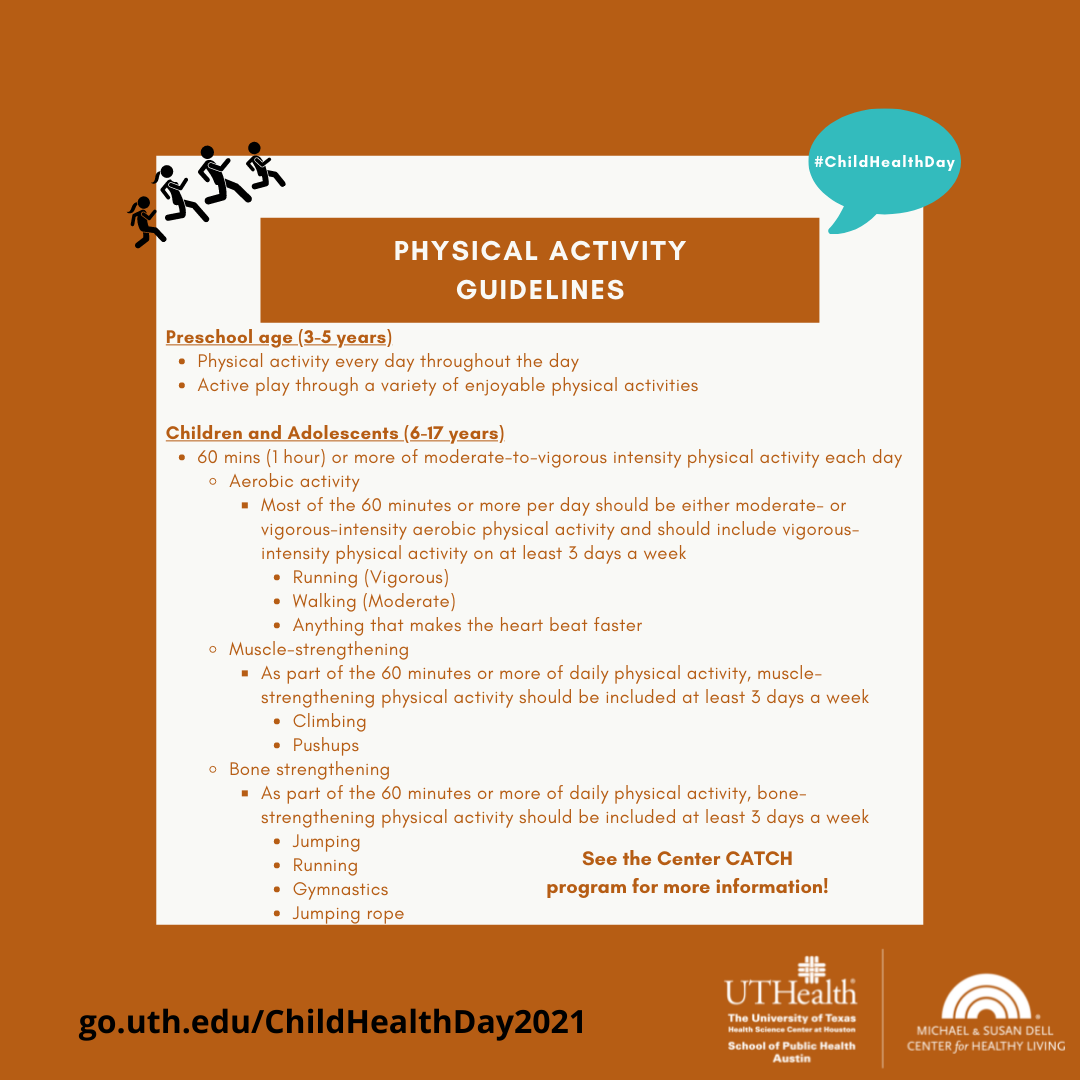
Sleep Guidelines6
Sleep is critical for children’s health because it helps to set a regular schedule for children and protect their physical and mental health. It is also critical for prevention of many diseases and health issues including type 2 diabetes, obesity, poor mental health, injuries, and attention or behavior problems. The checklist provides a guide for how much sleep your child needs based on the age group they fall in to (infants, toddlers, preschoolers, grade-schoolers, or teens).
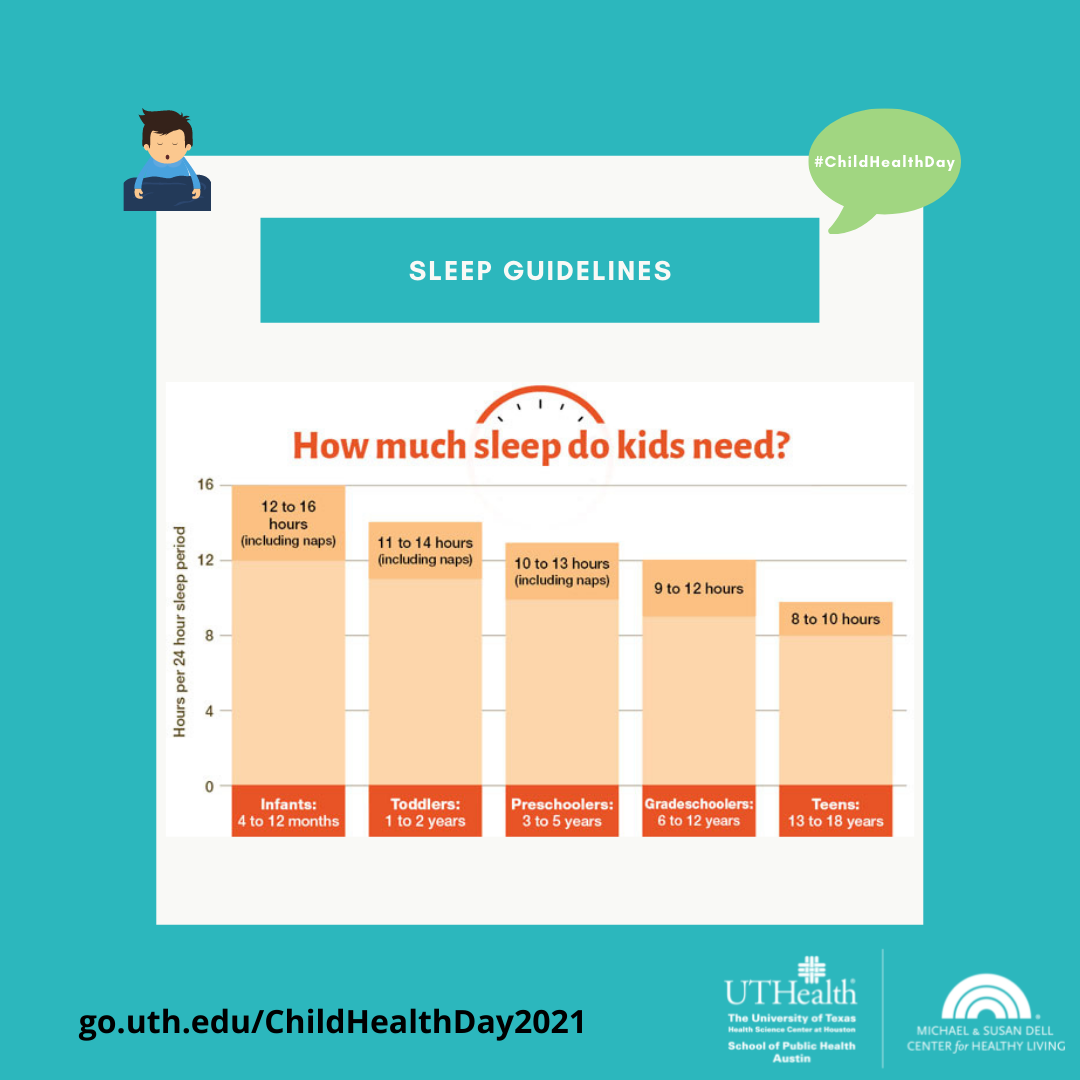
Screen Time Guidelines7
Screen time guidelines are an important aspect of child health because while they can help children learn and stay entertained, excessive screen time can lead to physical and mental health problems. These health problems can include sleep issues, lowered academic achievement in school, weight problems, mood problems, poor self-image issues, and many other developmental concerns. It is important to utilize screen time guidelines and general recommendations for screen time to help prioritize your child’s health!
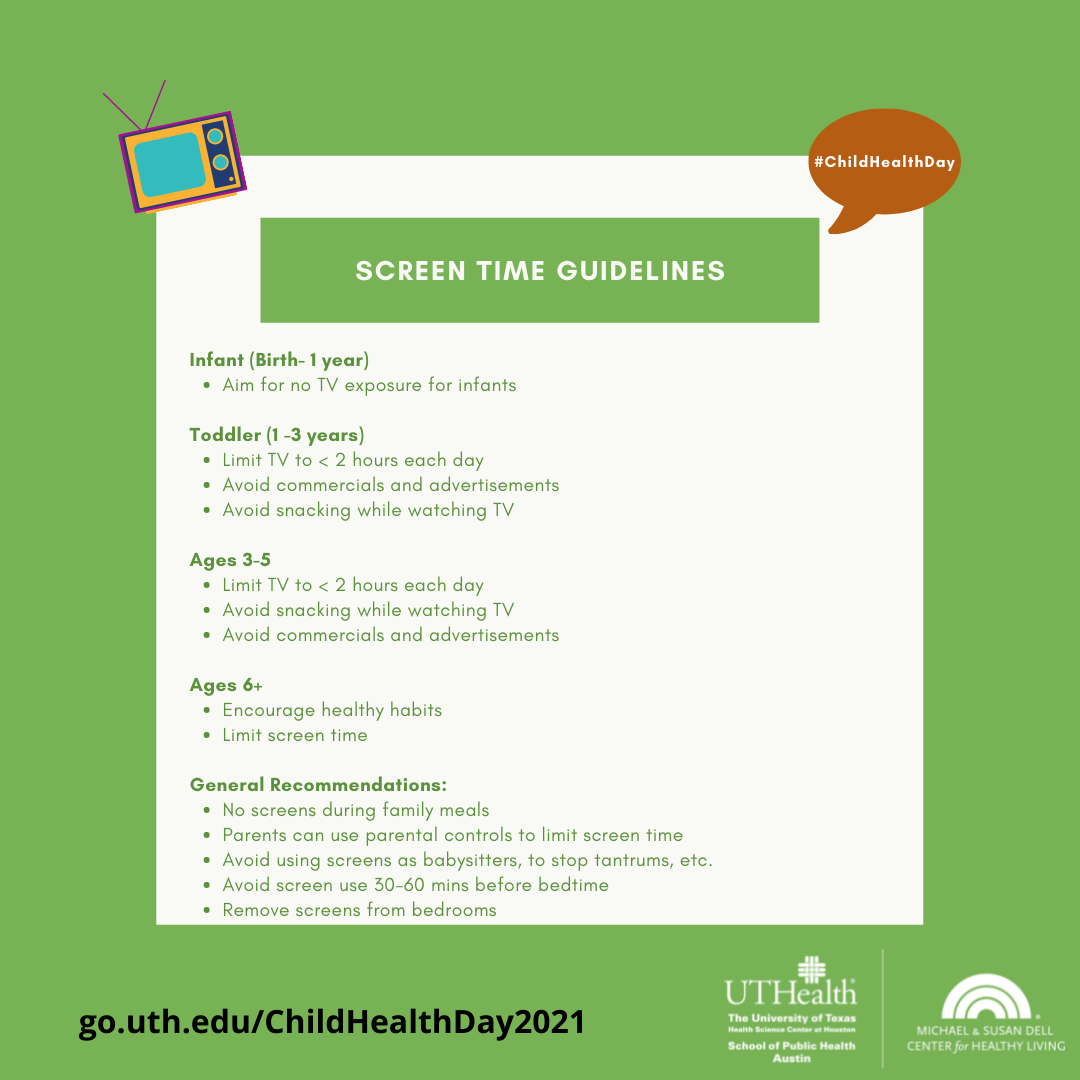
Written by:
Katherine Jones
MPH Candidate
UTHealth School of Public Health in Austin
Michael & Susan Dell Center for Healthy Living
References and Resources:
- https://www.aetnabetterhealth.com/texas/wellness/child/well-child-checkup#:~:text=Regular%20medical%20Texas%20Health%20Steps,24%20months%20and%2030%20months
- https://www.cdc.gov/oralhealth/basics/childrens-oral-health/index.html
- https://www.myplate.gov/eat-healthy/what-is-myplate
- https://www.cdc.gov/vaccines/imz-managers/laws/state-reqs.html
- https://www.cdc.gov/healthyschools/physicalactivity/guidelines.htm
- https://www.cdc.gov/chronicdisease/resources/infographic/children-sleep.htm
- https://www.aacap.org/AACAP/Families_and_Youth/Facts_for_Families/FFF-Guide/Children-And-Watching-TV-054.aspx
- https://www.aap.org/
- https://www.healthychildren.org/English/family-life/health-management/Pages/Well-Child-Care-A-Check-Up-for-Success.aspx
- https://www.aapd.org/resources/parent/faq/
- https://familydoctor.org/dental-hygiene-how-to-care-for-your-childs-teeth/
- https://kidshealth.org/en/teens/teeth.html
- https://www.mayoclinic.org/healthy-lifestyle/childrens-health/in-depth/nutrition-for-kids/art-20049335>
- https://www.dshs.texas.gov/immunize/school/school-requirements.aspx
- https://health.gov/sites/default/files/2019-09/Physical_Activity_Guidelines_2nd_edition.pdf
- https://www.cdc.gov/physicalactivity/basics/age-chart.html
- Paruthi S, Brooks LJ, D’Ambrosio C, Hall WA, Kotagal S, Lloyd RM, et al. Recommended amount of sleep for pediatric populations: a consensus statement of the American Academy of Sleep Medicine. J Clin Sleep Med. 2016;12(6):785–786.
- https://www.cdc.gov/sleep/about_sleep/how_much_sleep.html
- https://www.healthychildren.org/English/healthy-living/sleep/Pages/healthy-sleep-habits-how-many-hours-does-your-child-need.aspx?_gl=1*15pbiv2*_ga*MzIyNzkyODY0LjE2Mjk5MTQ5Mjc.*_ga_FD9D3XZVQQ*MTYyOTkxNDkyNi4xLjEuMTYyOTkxNDk5OS4w&_ga=2.105642052.635598397.1629914927-322792864.1629914927
- https://www.aap.org/en-us/advocacy-and-policy/aap-health-initiatives/HALF-Implementation-Guide/Age-Specific-Content/Pages/Infant-Physical-Acticity.aspx
- https://www.aap.org/en-us/advocacy-and-policy/aap-health-initiatives/HALF-Implementation-Guide/Age-Specific-Content/Pages/Preschooler-Physical-Activity.aspx
- https://www.aap.org/en-us/advocacy-and-policy/aap-health-initiatives/HALF-Implementation-Guide/Age-Specific-Content/Pages/Toddler-Physical-Activity.aspx
- https://www.aacap.org/AACAP/Families_and_Youth/Facts_for_Families/FFF-Guide/Children-And-Watching-TV-054.aspx
- https://www.cdc.gov/physicalactivity/basics/children/index.htm
- https://pediatrics.aappublications.org/content/139/6/e20170967#:~:text=Recommendations%20from%20the%20AAP%20and,a%20bottle%20in%20their%20mouth
- https://www.cdc.gov/vaccines/schedules/easy-to-read/child-easyread.html
- https://health.gov/sites/default/files/2019-09/Physical_Activity_Guidelines_2nd_edition.pdf
- https://www.myplate.gov/eat-healthy/food-group-gallery
- https://www.myplate.gov/
- https://sph.uth.edu/research/centers/dell/project.htm?project=eddbb8f0-a00a-4385-8e34-148e1712573c



Discussion